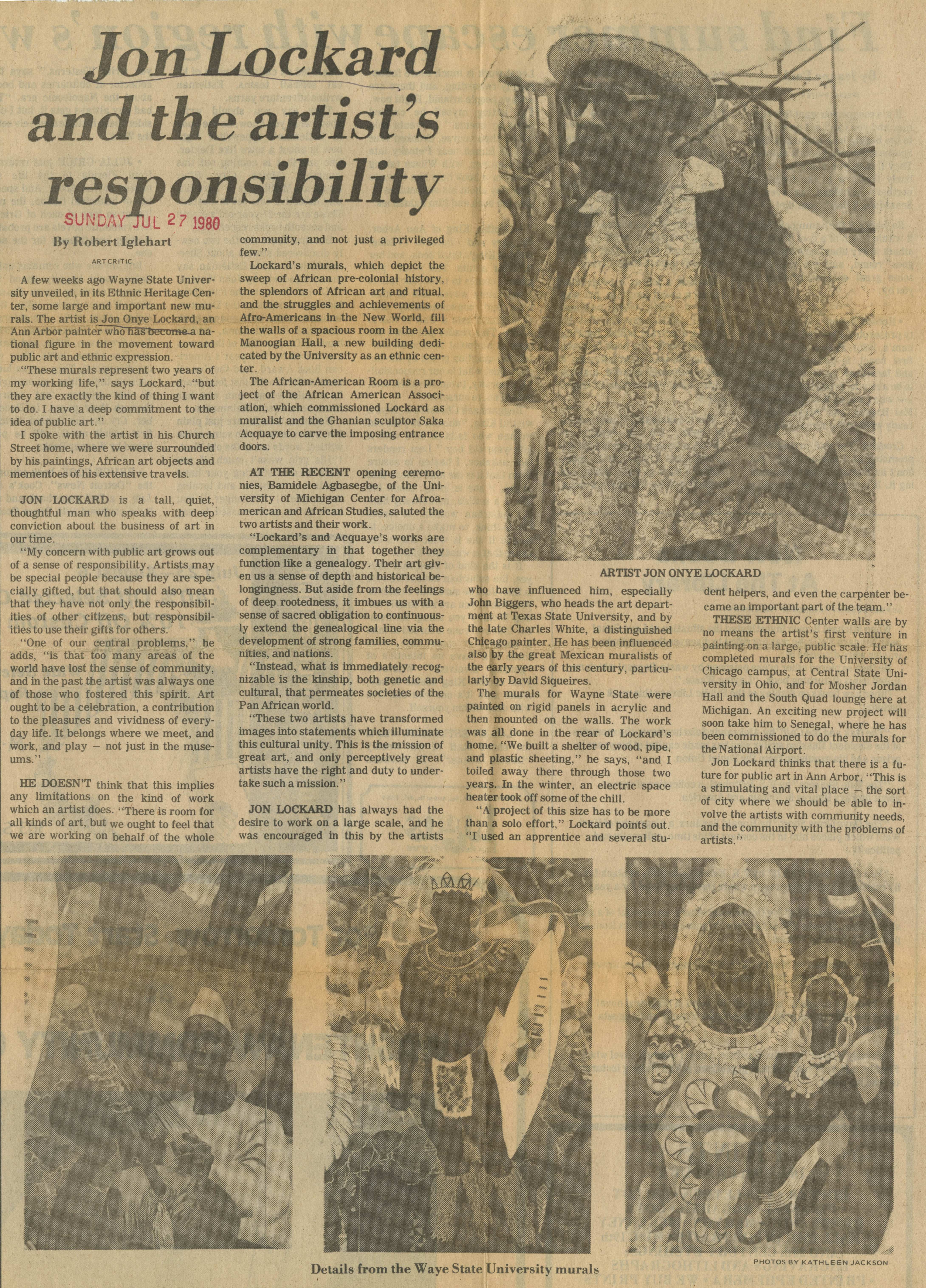Jon Lockard and the artist's responsibility

Jon Lockard and the artist’s responsibility
By Robert Iglehart
ARTCRITIC
A few weeks ago Wayne State University unveiled, in its Ethnic Heritage Center, some large and important new murals. The artist is Jon Onye Lockard, an Ann Arbor painter who has become a national figure in the movement toward public art and ethnic expression.
“These murals represent two years of my working life,” says Lockard, “but they are exactly the kind of thing I want to do. I have a deep commitment to the idea of public art.”
I spoke with the artist in his Church Street home, where we were surrounded by his paintings, African art objects and mementoes of his extensive travels.
JON LOCKARD is a tall, quiet, thoughtful man who speaks with deep conviction about the business of art in our time.
“My concern with public art grows out of a sense of responsibility. Artists may be special people because they are specially gifted, but that should also mean that they have not only the responsibilities of other citizens, but responsibilities to use their gifts for others.
"One of our central problems,” he adds, “is that too many areas of the world have lost the sense of community, and in the past the artist was always one of those who fostered this spirit. Art ought to be a celebration, a contribution to the pleasures and vividness of everyday life. It belongs where we meet, and work, and play - not just in the museums.”
HE DOESN’T think that this implies any limitations on the kind of work which an artist does. “There is room for all kinds of art, but we ought to feel that we are working on behalf of the whole community, and not just a privileged few.”
Lockard’s murals, which depict the sweep of African pre-colonial history, the splendors of African art and ritual, and the struggles and achievements of Afro-Americans in the New World, fill the walls of a spacious room in the Alex Manoogian Hall, a new building dedicated by the University as an ethnic center.
The African-American Room is a project of the African American Association, which commissioned Lockard as muralist and the Ghanian sculptor Saka Acquaye to carve the imposing entrance doors.
AT THE RECENT opening ceremonies, Bamidele Agbasegbe, of the University of Michigan Center for Afroamerican and African Studies, saluted the two artists and their work.
“Lockard’s and Acquaye’s works are complementary in that together they function like a genealogy. Their art given us a sense of depth and historical belongingness. But aside from the feelings of deep rootedness, it imbues us with a sense of sacred obligation to continuously extend the genealogical line via the development of strong families, communities, and nations.
“Instead, what is immediately recognizable is the kinship, both genetic and cultural, that permeates societies of the Pan African world.
“These two artists have transformed images into statements which illuminate this cultural unity. This is the mission of great art, and only perceptively great artists have the right and duty to undertake such a mission."
JON LOCKARD has always had the desire to work on a large scale, and he was encouraged in this by the artists who have influenced him, especially John Biggers, who heads the art department at Texas State University, and by the late Charles White, a distinguished Chicago painter. He has been influenced also by the great Mexican muralists of the early years of this century, particularly by David Siqueires.
The murals for Wayne State were painted on rigid panels in acrylic and then mounted on the walls. The work was all done in the rear of Lockard’s home. “We built a shelter of wood, pipe, and plastic sheeting,” he says, “and I toiled away there through those two years. In the winter, an electric space heater took off some of the chill.
“A project of this size has to be more than a solo effort,” Lockard points out. “I used an apprentice and several student helpers, and even the carpenter became an important part of the team.”
THESE ETHNIC Center walls are by no means the artist’s first venture in painting on a large, public scale. He has completed murals for the University of Chicago campus, at Central State University in Ohio, and for Mosher Jordan Hall and the South Quad lounge here at Michigan. An exciting new project will soon take him to Senegal, where he has been commissioned to do the murals for the National Airport.
Jon Lockard thinks that there is a future for public art in Ann Arbor, “This is a stimulating and vital place - the sort of city where we should be able to involve the artists with community needs, and the community with the problems of artists.”
Article
Subjects
Robert Iglehart
Wayne State University
Murals
Art & Artists
Black Americans
University of Michigan - Center for Afro-American & African Studies
Has Photo
Old News
Ann Arbor News
Jon Onye Lockard
Saka Acquaye
Bamidele Agbasegbe
John Biggers
Charles White
David Siqueires
Kathleen Jackson